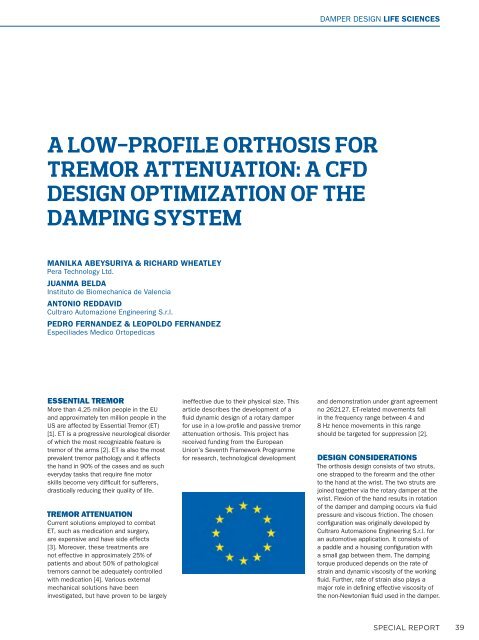Life science special report 161215 IY opt
You also want an ePaper? Increase the reach of your titles
YUMPU automatically turns print PDFs into web optimized ePapers that Google loves.
DAMPER DESIGN LIFE SCIENCES<br />
A LOW-PROFILE ORTHOSIS FOR<br />
TREMOR ATTENUATION: A CFD<br />
DESIGN OPTIMIZATION OF THE<br />
DAMPING SYSTEM<br />
MANILKA ABEYSUR<strong>IY</strong>A & RICHARD WHEATLEY<br />
Pera Technology Ltd.<br />
JUANMA BELDA<br />
Instituto de Biomechanica de Valencia<br />
ANTONIO REDDAVID<br />
Cultraro Automazione Engineering S.r.l.<br />
PEDRO FERNANDEZ & LEOPOLDO FERNANDEZ<br />
Especiliades Medico Ortopedicas<br />
ESSENTIAL TREMOR<br />
More than 4.25 million people in the EU<br />
and approximately ten million people in the<br />
US are affected by Essential Tremor (ET)<br />
[1]. ET is a progressive neurological disorder<br />
of which the most recognizable feature is<br />
tremor of the arms [2]. ET is also the most<br />
prevalent tremor pathology and it affects<br />
the hand in 90% of the cases and as such<br />
everyday tasks that require fine motor<br />
skills become very difficult for sufferers,<br />
drastically reducing their quality of life.<br />
TREMOR ATTENUATION<br />
Current solutions employed to combat<br />
ET, such as medication and surgery,<br />
are expensive and have side effects<br />
[3]. Moreover, these treatments are<br />
not effective in approximately 25% of<br />
patients and about 50% of pathological<br />
tremors cannot be adequately controlled<br />
with medication [4]. Various external<br />
mechanical solutions have been<br />
investigated, but have proven to be largely<br />
ineffective due to their physical size. This<br />
article describes the development of a<br />
fluid dynamic design of a rotary damper<br />
for use in a low-profile and passive tremor<br />
attenuation orthosis. This project has<br />
received funding from the European<br />
Union’s Seventh Framework Programme<br />
for research, technological development<br />
and demonstration under grant agreement<br />
no 262127. ET-related movements fall<br />
in the frequency range between 4 and<br />
8 Hz hence movements in this range<br />
should be targeted for suppression [2].<br />
DESIGN CONSIDERATIONS<br />
The orthosis design consists of two struts,<br />
one strapped to the forearm and the other<br />
to the hand at the wrist. The two struts are<br />
joined together via the rotary damper at the<br />
wrist. Flexion of the hand results in rotation<br />
of the damper and damping occurs via fluid<br />
pressure and viscous friction. The chosen<br />
configuration was originally developed by<br />
Cultraro Automazione Engineering S.r.l. for<br />
an automotive application. It consists of<br />
a paddle and a housing configuration with<br />
a small gap between them. The damping<br />
torque produced depends on the rate of<br />
strain and dynamic viscosity of the working<br />
fluid. Further, rate of strain also plays a<br />
major role in defining effective viscosity of<br />
the non-Newtonian fluid used in the damper.<br />
SPECIAL REPORT<br />
39



